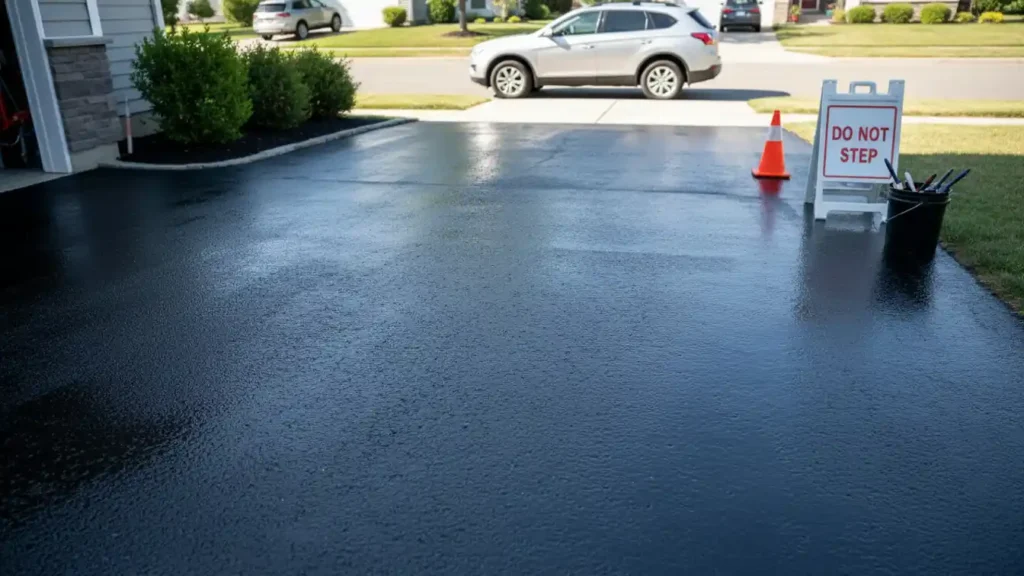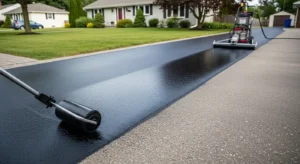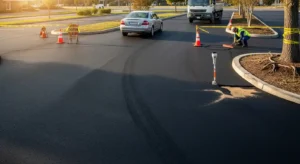The black sealer bucket is empty on your garage floor. Your driveway looks amazing with that fresh, dark coat shining in the sun. But now there’s a problem you didn’t think about. Your car’s been on the street for hours. The mail carrier almost hit it twice. Your neighbor just came by asking when you’re moving it. And you’re standing there, not knowing when it’s actually safe to drive on your driveway.
The bucket probably had instructions about drying time, but you already threw it away. Now you’re guessing. Maybe it’s ready tomorrow. Maybe it will take three days. Drying time isn’t just about waiting a certain number of hours. Weather changes everything. The type of sealer matters. How you put it matters too. In this post, we’ll explain exactly when your driveway is ready. You’ll find out when it’s okay to walk on it, when it’s safe to drive, and how to avoid messing up all that hard work.
Understanding Driveway Sealer
Before we talk about drying times, let’s cover what you actually just put on your driveway. Sealer isn’t like regular paint. It’s a protective coating designed to shield your asphalt from everything life throws at it.
Your driveway takes a beating every single day. Rain soaks into it. Oil drips from your car. The sun bakes it all summer. Winter brings freezing temperatures that crack the surface. Without protection, asphalt breaks down fast. You’ll see it turn gray and chalky. Small cracks become big problems.
Sealer creates a waterproof barrier. It keeps moisture out and blocks UV rays that damage the asphalt. It even helps repel oil and gasoline spills. Most importantly, it makes your driveway look brand new again with that fresh black finish.
There are different types of sealers out there. Asphalt emulsion sealers are the most common these days. They’re water-based, which makes cleanup easier. Coal tar sealers used to be popular but are getting banned in many areas. Fast-dry sealers promise quicker curing times but usually cost more.
The Real Timeline: Walking vs. Driving
Alright, let’s get to what everyone wants to know. When can you use your driveway again? For walking, you’re looking at about 3 to 8 hours under good conditions. That’s when the surface is dry enough that you won’t leave footprints or track sealer into your house. But walking and driving are completely different.
Driving requires way more patience. Most experts recommend waiting at least 24 hours before you put a vehicle on freshly sealed asphalt. Many say 48 hours is even better. I’d personally go with the 48-hour mark, especially if you’ve got a heavy truck or SUV.
Here’s where people get confused: “dry” and “cured” aren’t the same thing. After 12 hours, your driveway might feel dry to the touch. You can press your hand on it and nothing comes off. That doesn’t mean it’s hard enough to handle thousands of pounds of vehicle weight.
Think of it like baking brownies. They might look done on top, but cut into them too early and you’ve got a gooey mess inside. Sealer works the same way. The surface dries first while the layers underneath need more time.
Fast-dry products claim you can drive on them in 8 to 12 hours. Maybe that works under perfect conditions. But “perfect conditions” rarely happen in real life. Weather changes and temperatures drop at night.
Want my honest take? Give it a full 48 hours before you park your car on it. Better yet, wait 72 hours if you can manage it. Yeah, parking on the street is annoying. But you know what’s worse? Permanent tire marks embedded in your fresh seal coat.
What Affects Drying Time
You’d think drying would be straightforward. Apply sealer, wait X hours, done. Nope. Dozens of factors affect how quickly that coating hardens up.
The temperature is huge. Sealer works best between 50 and 90 degrees Fahrenheit. Below 50, the drying process crawls. Below 40? Don’t even bother. The sealer might not cure properly at all. Above 90 degrees causes problems too. The surface can dry too fast while staying soft underneath.
I learned about temperature the hard way. Sealed my driveway one October weekend when days were gorgeous. Didn’t think about how cold nights got. Temperatures dropped into the low 40s. That sealer took almost four full days to cure because every night it basically stopped drying.
Humidity plays a bigger role than most people realize. High humidity means moisture’s already saturating the air. Your sealer needs to dry by evaporating water, but where’s that water supposed to go if the air can’t hold any more? Dry days with humidity below 60% are your best friend.
Sunlight makes a massive difference. A driveway in full sun all day dries way faster than one shaded by trees. UV rays actually help the curing process along. If half your driveway sits in shade, you’ll notice that section takes longer.
Wind helps move things along. Air circulation carries moisture away from the surface. A breezy day speeds up drying. No wind? Everything slows down.
How thick you applied the sealer matters more than you’d think. Some folks figure if one coat is good, a really thick coat must be better. Wrong. Thick coats trap moisture underneath and take forever to cure. You’re always better off doing two thin coats instead of one thick one.
How to Tell When It’s Ready
Don’t just guess based on the clock. Your driveway will tell you when it’s ready if you pay attention. Find a spot away from the main traffic area and touch it gently. If your finger comes away clean and the surface feels hard, that’s promising. If it’s still tacky or soft, back away and give it more time.
Look at the color across the entire surface. Wet sealer is super dark and shiny. As it dries, the color lightens slightly and loses that glossy wet look. When everything looks consistent with no shiny patches, you’re getting close.
Pay extra attention to edges and corners. These spots don’t get as much airflow, so they dry slower than the middle sections. I always check these areas last. If they’re ready, everything else definitely is.
Here’s a trick professionals use: place a small piece of cardboard on the sealer for about 15 minutes. Lift it up carefully. If any sealer is stuck to it, you need more drying time.
Try walking on it before driving on it. After about 8 hours, test a small section on foot. If you don’t leave footprints and your shoes don’t pick up any residue, walking is probably safe.
Ways to Speed Up Drying
You can’t force sealer to dry on your schedule, but you can create better conditions. Pick your timing carefully. Check the weather forecast for at least three or four days out. You want warm, dry weather the entire time. A long weekend is perfect for this project.
Start early in the morning. Get that sealer down by 9 or 10 AM if possible. This gives you maximum sun and warmth for drying. Starting at 4 PM means you lose all those good drying hours to cooler evening temps.
Apply thin coats. I can’t stress this enough. A thin, even coat dries faster than a thick one and actually protects better. If you want more coverage, do a second thin coat after the first one completely dries.
Fast-dry sealers cost more but they’re worth considering if you’re in a time crunch. Just know they usually require stricter application conditions. Clear everything away before you start. Don’t have cars parked nearby that might need moving. Don’t plan on anyone needing to walk across the area.
Common Mistakes to Avoid
People mess this up in predictable ways. Learn from their mistakes instead of making your own. Sealing when rain’s in the forecast is probably the number one disaster. You check the weather, see no rain for 24 hours, and figure you’re good. Then a surprise shower rolls through and ruins everything. If there’s even a slight chance of rain within 48 hours, reschedule.
Skipping the prep work is another classic error. Your driveway needs to be completely clean and dry before you seal it. If you pressure washed it, wait at least 24 hours for it to dry. Sealing in cold weather never works out well. The bucket might say you can apply it above 50 degrees, but that’s the bare minimum. Wait for proper warm weather.
Letting people walk on it too early ruins lots of driveways. Block off the area and don’t let anyone near it until you’re absolutely certain it’s ready. Driving on it before it’s cured destroys more sealing jobs than anything else. Your car weighs thousands of pounds. Even if the sealer feels dry, all that weight can leave permanent marks.
Maintaining Your Sealed Driveway
You’ve done all this work. Make it last as long as possible. Don’t park in the exact same spot every single day. Mix it up. Park on different areas of the driveway. This spreads out wear and makes your sealer last longer.
Clean up oil spills right away. Sealer helps protect against oil, but it’s not magic. If you let oil sit there for weeks, it’ll eventually break down the sealer. Avoid hard turns with your wheels cranked all the way, especially in hot weather. This creates friction that can scuff the sealer.
Watch for new cracks developing. If you see cracks forming, patch them before they spread. Small repairs now prevent big expensive problems later. Plan on resealing every 2 to 3 years. Even the best sealer doesn’t last forever. Regular maintenance prevents catastrophic failures.
Take Action Today
You’ve got all the information you need to seal your driveway the right way. Don’t wait until those small cracks turn into major problems. Check your weather forecast, grab the right supplies, and plan your sealing project for the next warm weekend.
Remember, a little patience now saves you from permanent mistakes later. Ready to get started? Share your driveway sealing experience in the comments below, and let us know if you have any questions. We’re here to help you get professional results without the professional price tag.
Conclusion
Sealing your driveway isn’t rocket science, but the drying time part trips up more people than you’d expect. You can’t rush chemistry. The sealer needs proper time to cure.
Planning ahead is everything. Pick good weather, prep your surface properly, apply thin coats, and then practice patience. Parking on the street for two or three days is mildly annoying. Having permanent tire tracks scarring your driveway for years is way worse.
Most driveways are ready for normal use somewhere between 24 and 48 hours after sealing. Your specific situation might need more time depending on weather and temperature. When you’re not sure, add another day.
Your driveway gets hammered by weather, vehicles, and time every single day. Protecting it with sealer is smart home maintenance. Take your time, follow these guidelines, and you’ll have a driveway that looks amazing and holds up for years.
Frequently Asked Questions
Can I seal my driveway if rain is forecast in 48 hours?
It’s risky. Most sealers need at least 48-72 hours of completely dry weather to cure properly. If rain hits before your sealer’s ready, you’re looking at streaks, washouts, and possibly starting over.
What happens if someone drives on the sealer too early?
You’ll see tire marks, impressions, or areas where the sealer gets pulled up. These marks are usually permanent and make your driveway look terrible.
Is it safe to walk on the driveway before cars can drive on it?
Yes, walking is usually fine after 4 to 8 hours if the surface feels dry. Walking doesn’t put nearly the same pressure on the sealer as a vehicle.
Does sealer dry faster in hot or cold weather?
Hot weather speeds up drying, but there’s a sweet spot. Temperatures between 70 and 85 degrees are perfect. Above 90 can cause problems.
Can I use a heater to speed up drying?
Don’t even think about it. Forcing the sealer to dry with artificial heat causes bubbling, cracking, and uneven curing.






